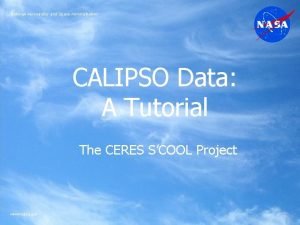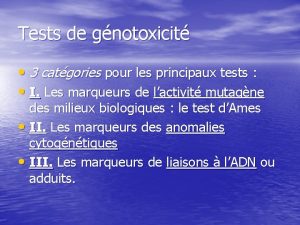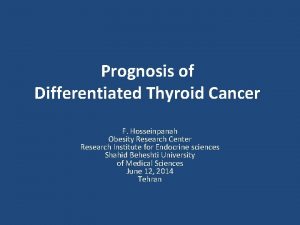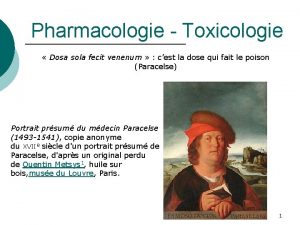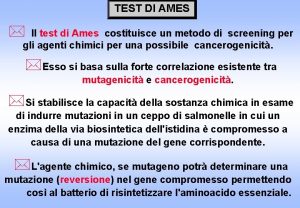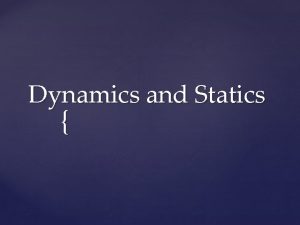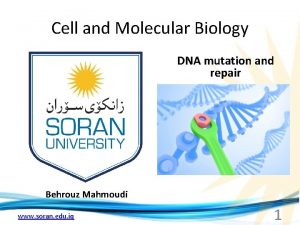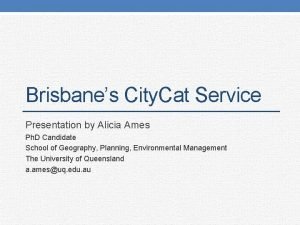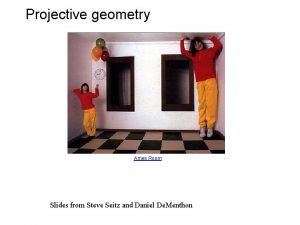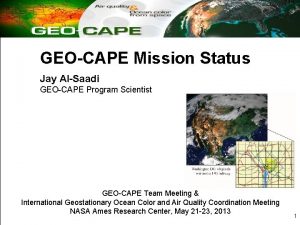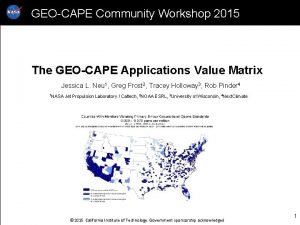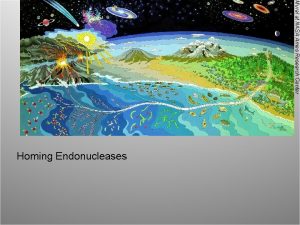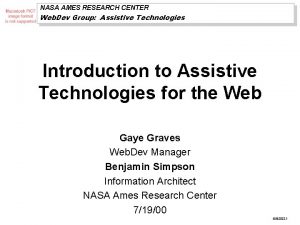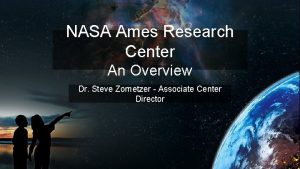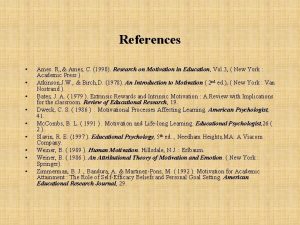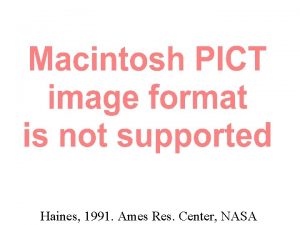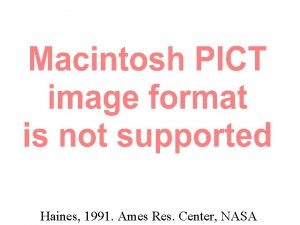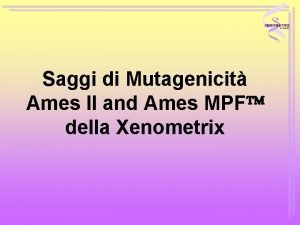GEOCAPE Team Meeting NASA Ames Research Center May













- Slides: 13

GEO-CAPE Team Meeting NASA Ames Research Center, May 2013 GEO-CAPE Atmospheric Composition and the Applications Community: The Applications Traceability Matrix Jessica L. Neu (JPL/Caltech) and Rob Pinder (EPA) © 2014 All Rights Reserved

Applications Community Stakeholder Expectations Ø Maximize near-surface sensitivity for all species to support emissions inventories, source attribution, public health applications. Ø Provide measurements of species not well-covered by in situ, ground-based measurements. For species that are covered by ground-based measurements, provide spatio-temporal coverage and accuracy that complements in situ measurements Ø Obtain a long record of measurements for understanding the impact of meteorological variability, anthropogenic trends, and extreme events on emissions and concentrations Ø Measure aerosol optical depth, CH 4 concentration and O 3 longwave radiative flux to support SLCF policy making Ø Provide multiple years of overlap with TEMPO for concurrent measurements of key precursors and criteria pollutants (O 3 and CO, NH 3 and aerosols) to support source attribution Ø Provide multiple years of overlap with Korean and European GEO missions to quantify intercontinental transport. Ø Generate near-real-time products to support forecasting, exceedance analysis, and monitoring of extreme events.

Background of the Applications Traceability Matrix Ø First suggested by Terry Keating and Jim Szykman at the Satellite Observations for Air Quality Management Workshop in Boulder (2011) Ø One goal of the workshop was to create a process to better understand the suitability of satellite observations for air quality management applications, as well as traceability to the current and future stream of satellite observations Ø “How you can help us help you” What will the data products from GEOCAPE look like? Put simulated data in the hands of air quality analysts. Communicate potential value to Air Quality Agency management (national, state, local). Create a demand for the mission Ø Based on discussions at the Boulder GEO-CAPE Community Workshop, an Applications Working Group was established within the GEO-CAPE Atmospheric Composition SWG, with the goal of developing an Applications Traceability Matrix and interfacing with the applications community

The ATM: Applications Categories Ø Source Attribution O 3 NOx PM 2. 5 CH 4 NH 3 Ø Forecasting O 3 PM 2. 5 Ø Extreme Events Ø Trends / Compliance / Monitoring O 3 CO NOx SO 2 PM 2. 5 CH 4 Forest Fires Dust Storms Volcanoes Ø Quantifying the N. American Background O 3 PM 2. 5 Ø Radiative Forcing O 3 Aerosols CH 4 Ø Quantifying Emissions CO NO 2 HCOH+VOCs SO 2 PM 2. 5 CH 4 NH 3 Agricultural Burning Wildfires There is a column for weighting the importance of the applications categories, but we are finding that the answer depends very strongly on who evaluates the weighting, so it may not be a useful metric

The ATM

The ATM: Instructions and Metrics Ø The goal is to identify which mission options support stakeholder applications. Ø We will determine the utility of each measurement by assessing: Does the technical specification of the measurement (resolution, precision, etc. ) help inform this application? Does the measurement provide unique information, or is there existing data that already supports this application in a more robust way? Ø For each "white" square in the matrix, put a value from 0 -- 5, asking yourself, does this measurement… 0 Provide no support to this application 1 Provide little support to this application 2 Provide some support to this application that is somewhat duplicative of other available data 3 Provide some support to this application in a way that is not duplicated in other available data 4 Provide a high level of support to this application that is not possible without this measurement 5 Would fundamentally change the paradigm of air quality management in a way that is not possible without this measurement Ø The exercise is to be completed for the "goal" mission, as described in the GEO-CAPE STM. Ø The accompanying document provides a brief description of the GEO-CAPE measurements

The ATM: Accompanying Documentation To aid users in evaluating the GEO-CAPE data, we compiled a description of each of the GEO-CAPE measurements, including measurement requirements and results from relevant sensitivity studies and OSSEs Figure from Natraj et al. 2011

Not Evaluated The ATM: EPA Beta Testing Results

The ATM: EPA Beta Testing Analysis Ø GEO-CAPE is a game changer for the applications community Ø Applications has different needs than science – CH 4 and NH 3 have higher relative importance than they do in the SVM Ø O 3 has lower total importance but a high mean score Ø NO 2 is the most important molecule There is good near-surface sensitivity There is not good in situ coverage NO 2 contributes to the largest number of applications categories

The ATM: EPA Beta Testing Analysis Ø NO 2 scores highly because: It is a precursor for both O 3 and PM 2. 5 It has anthropogenic emissions as well as emissions from episodic events such as fires Ø O 3 has relatively low importance because its usefulness is limited to O 3 centric applications (O 3 source attribution, radiative forcing, forecasting…. ) Ø Aerosols and CO are most useful for: Quantifying emissions (particularly fires) Monitoring extreme events Ø NH 3 and CH 4 are most useful for: Quantifying emissions Source attribution CH 4 is also important for radiative forcing Scores By Application

The ATM: EPA Beta Testing Analysis Synergies Between Measurements for Ozone Applications Ø Lack of assessment of the synergies between measurements has been identified as a weakness of the SVM analysis Ø 5 species make significant contributions to ozone applications Ø The species can only be measured by a combination of TEMPO and GCIRI

Next Steps Ø We will implement changes based on our “lessons learned” and disseminate to a wider group of applications experts Ø We have identified people from: EPA, especially the Working Group on Use of Satellite Observations in Air Quality Management Air Quality Applied Science Team Regional air quality management Other suggestions are welcome! Ø We will include product confidence (and eventually cost) in our analysis

Discussion points Ø Is the current approach of breaking the applications down by species over-valuing some species? Ø Are there important things we’re missing (e. g. air quality in the mountain west)? Ø Are the differences in approach and metrics between the STM and ATM appropriate? Ø How do we value ATM input relative to science?

